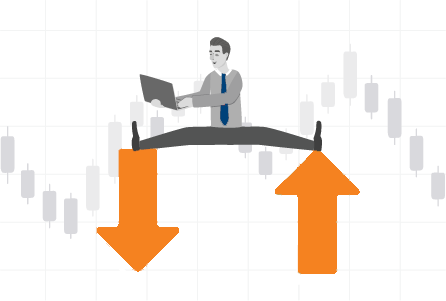- ZERO AMC for the first year**
- Dial-N-Trade at ZERO cost
- Get directional Buy-side recommendations at ZERO cost
- Get multi-leg Options strategies at ZERO cost
- 29 years of customer trust

What is Options trading?
Options are a type of Derivative instrument that’s traded in the market. Derivatives, which have no inherent value of their own, derive their value from changes in the price of other financial instruments, known as the underlying asset. There are mainly 4 types of underlying assets: stocks, indices, currency pairs, and commodities. A derivative's price follows the price of the underlying security from which it derives its value.
Trading Options enables you to buy or sell stocks, indices, currency pairs, and commodities at a set price and on a particular date. Additionally, with Options trading, buyers have the choice NOT to purchase the asset at the predetermined price or time. This is the major difference between Futures and Options. While buying and selling Futures are obligatory, buying and selling Options are not.
Good-to-knows about Options trading
- Options trading can help you make significantly higher profits if the price of the security increases. However, note that it is more complicated than stock trading.
- When doing Options trading, you can buy a contract at a fraction of the market price of the underlying securities.
- Hedging is the process of using Options trading to limit losses if the price of the underlying security declines.
- The terms "Call" and "Put" refer to the purchase and sale of respective securities.
- Traders who trade in the Options market primarily want to take advantage of price fluctuations. Alternatively, they aim to mitigate the risks associated with Commodity price fluctuations.
- When buying an Options contract, an investor makes a small up-front payment instead of the complete sum. The trader has now locked in the price of the underlying asset or commodity till the contract’s expiration date.
- Being a derivative asset, the contract's price shifts from time to time as the underlying asset’s price varies, which affects the trader's profit or loss.
- In India, the BSE and NSE stock exchanges mediate in the F&O segment and keep an eye on each contract.
Trading in Options market
Options are not that different from Futures, except for one major factor – the obligatory nature of Futures contracts. Options contracts perform the same function as Futures contracts do for purchasers, by establishing a predetermined future price for an underlying asset, but without the obligation to buy that is included in a Futures contract.
If the buyer decides to execute the Options contract on or before the agreed date, in exchange for an upfront payment from the buyer, the seller has no rights and must sell the assets at the agreed price.
When an Options contract is signed, no actual paper documents are transferred. The stock exchange where the transactions are routed merely records them.
Heard these Options terms before?
You may encounter many phrases that may seem foreign when investing in the Derivatives (F&O) market. Here are some terms linked to Options that you should be aware of:
Premium
The upfront payment the buyer makes to the seller to take advantage of an Options contract's benefits.
Strike price / Exercise price
The specified price at which an asset may be purchased or sold is known as the "strike price" or "exercise price".
Strike price intervals
Strike price intervals: The various strike prices at which an Options contract can be exchanged are known as strike price intervals. The stock exchange where the assets are traded determines these intervals. Every type of Option typically has at least 11 strike prices declared in a given month, including 5 values above the spot price, 5 below the market price, and 1 price that is the same as the spot price.
In-the-money (ITM) / Out-of-the-money (OTM):
In-the-money (ITM) / Out-of-the-money (OTM): You are in-the-money (ITM) when you can earn a profit by implementing the Option at that time. And you are out-of-the-money (OTM) when you may face losses after exercising the Option at that time.
Example of hedging with Options
Options can be used by corn producers to get a fixed price for selling their harvest. They lessen their risk and ensure they will get the predetermined price by doing this. The farmer would profit from the hedge if the price of corn fell, which would help to make up for any losses from selling the corn at the market. The hedging successfully locks in a fair market price because the gains and losses are balanced out.
Example of speculating with Options
Suppose a Call option on stocks of XYZ Ltd. has a strike price of Rs 500 and a three-month expiration date. The stock is currently trading at Rs 450. You can purchase XYZ stocks at the strike price of Rs 500 under the terms of the Options contract at any time during the next three months. You can exercise your Call option and purchase the stock for Rs 500 only if the strike price increases at any time during the expiration period. By doing this, you can benefit as the Call option approaches in-the-money (ITM).
Example of hedging with Options
Options can be used by corn producers to get a fixed price for selling their harvest. They lessen their risk and ensure they will get the predetermined price by doing this. The farmer would profit from the hedge if the price of corn fell, which would help to make up for any losses from selling the corn at the market. The hedging successfully locks in a fair market price because the gains and losses are balanced out.
Example of speculating with Options
Suppose a Call option on stocks of XYZ Ltd. has a strike price of Rs 500 and a three-month expiration date. The stock is currently trading at Rs 450. You can purchase XYZ stocks at the strike price of Rs 500 under the terms of the Options contract at any time during the next three months. You can exercise your Call option and purchase the stock for Rs 500 only if the strike price increases at any time during the expiration period. By doing this, you can benefit as the Call option approaches in-the-money (ITM).

More about Derivatives products
Both Futures and Options are classified as Derivatives.
Futures
Futures are agreements between two parties to trade (buy or sell) a certain asset at a defined price and at a predetermined future date.
Options
On the other hand, Options are contracts that grant the buyer a right rather than an obligation to carry out their end of the bargain.
There are two types of Options trading in India: Call Options and Put Options.
Call Options: With a Call Option, you have the ability to use your purchasing power (at the strike price) before the Options contract expires.
Put Options: A Put Option gives you the option to sell at the strike price before the Option expires.
Benefits of opening an Options trading account
Benefits of opening an Options trading account
-
Highly leveraged investments: Ideal to optimize your earnings
-
Market is very liquid: Quick orders and no dramatic fluctuations
-
Fewer charges: Execution costs and commissions are low
-
Great for diversification or hedging:
-
More efficient and fair markets:
Options are well suited for
Leveraging: Trading Options enables you to profit from fluctuations in share prices without having to invest the full share price; that is, you are paying only the premium amount to trade in Options.
Hedging: By enabling you to buy or sell shares at a predetermined price for a set length of time, you can use them to safeguard yourself against changes in the price of a share.
As we’ve seen earlier, Futures are ideal for speculating, sometimes even better than other financial instruments. Although it might seem like it at first, Futures do not carry a higher level of risk than other market instruments like stocks, currencies or commodities.
When trading Futures, you should know that these are highly leveraged instruments and can be used to greatly increase your earnings. Futures and Options are used by hedgers to protect themselves from irrational or quick future price changes in the underlying Cash commodity. Market speculators use Futures & Options to make large profits in a short time span.

How to open an Options trading account?
At Mirae Asset Sharekhan, it takes just 3 steps to open an equity trading account (also known as a Demat account). And once you have a Demat account, activating the Options segment is seamless and easy. Let’s see the steps:
STEP 1
Fill in your basic personal details
STEP 2
Upload a few KYC documents (like PAN, Aadhaar, cancelled cheque) that are SEBI-mandated to open a Demat & Trading account
STEP 3
The Demat & Trading account is activated post verification
STEP 4
To activate Options, Proof of Income is to be submitted, which can be done 100% online via the Mirae Asset Sharekhan app or website
Why invest in Options trading through Mirae Asset Sharekhan
We’ve taken our F&O knowledge accumulated over 2 decades to craft Tools and Research methodologies that actually work!
We know the opportunities that Options present, and we’ve built an F&O ecosystem that delivers for you.
Option Writing Recommendations
| Strategy | No. of Legs | Typical Days |
|---|---|---|
| Delta Neutral | 2 | Wednesday – Monday |
| BankNIFTY Positional | 4 | Friday – Tuesday |
| BankNIFTY Expiry | 4 | Thursday |
| FinNIFTY Expiry | 4 | Thursday |
Option Buying Recommendations
| Strategy | No. of Legs | Typical Days |
|---|---|---|
| Options Unicorn | 1 | Daily |
| Hero Ya Zero | 1 | Tuesday and Thursday |
Derivative trading FAQs
Is F&O trading safe?
Futures are ideal for speculating, sometimes even better than other financial instruments. Futures do not carry a higher level of risk than other market instruments like stocks, currencies or commodities. When trading Futures, you should know that these are highly leveraged instruments and can be used to greatly increase your earnings. Futures are used by hedgers to protect themselves from irrational or quick future price changes in the underlying Cash commodity. Market speculators use Futures to make large profits in a short time span.
What Are the 3 Important Characteristics of Options?
Futures are ideal for speculating, sometimes even better than other financial instruments. Futures do not carry a higher level of risk than other market instruments like stocks, currencies or commodities. When trading Futures, you should know that these are highly leveraged instruments and can be used to greatly increase your earnings. Futures are used by hedgers to protect themselves from irrational or quick future price changes in the underlying Cash commodity. Market speculators use Futures to make large profits in a short time span.
How much money do you need to open a options account?
Yes, Futures are a type of Derivative instrument that’s traded in the market, along with Options. Derivatives, which have no inherent value of their own, derive their value from changes in the price of other financial instruments, known as the underlying asset. There are mainly 4 types of underlying assets: stocks, indices, currency pairs, and commodities. A derivative's price follows the price of the underlying asset from which it derives its value.
Is trading Options better than trading stocks?
Whether to trade/invest in stocks or trade in Options depends on your tastes, risk appetite and investing strategy. Stock trading may appeal to novice investors who seek to keep things straightforward. Options trading, on the other hand, is suited to seasoned investors who desire a more proactive investment approach with regard to market movements.
No investment type is superior or inferior to others, and none should be disregarded outright in favour of another. Stock market participants like you can choose between either choices or both; nevertheless, you must be aware of the associated risks and rewards.
What is Options trading?
Trading Options enables you to buy or sell stocks, indices, currency pairs, and commodities at a set price and on a particular date. Additionally, with Options trading, buyers have the choice NOT to purchase the asset at the predetermined price or time. This is the major difference between Futures and Options. While buying and selling Futures are obligatory, buying and selling Options are not.


